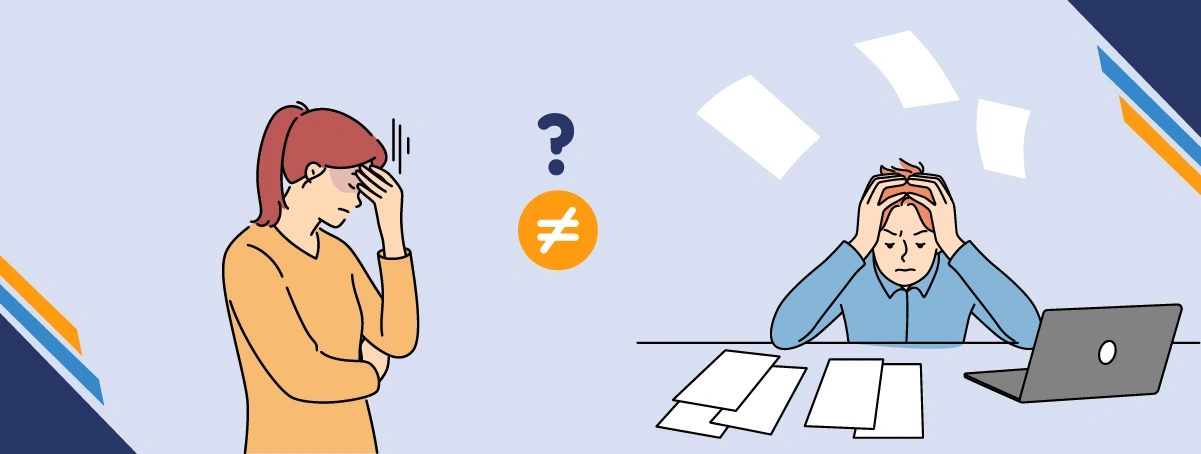
What’s the Difference Between Anxiety and Burnout?
Anxiety and burnout are two distinct mental health conditions that cause distress in every area of life, such as social gatherings, work, and relationships. Anxiety is a common mental health condition that can occur suddenly without a clear cause. On the other hand, burnout is a state of mental and physical exhaustion that leaves you drained, irritable, and overwhelmed. These conditions can occur together but have different symptoms and require different treatments.
This article provides a deep insight into the difference between anxiety and burnout, differences in symptoms, differences in terms of motivation, root cause, speed of onset, and more.
Anxiety Vs Burnout: Key Differences
Here is a breakdown of the difference between anxiety and burnout.
Emotional Difference
Anxiety and burnout have significant emotional differences and features. Individuals with burnout have low energy, whereas individuals with anxiety are caught up in excessive worry or threat. This table will help you understand the emotional differences of anxiety and burnout.
| Anxiety | Burnout | |
| Core emotions | Excessive worry and fear | Emotional exhaustion and unresponsiveness |
| Emotional expression | It involves panic attacks and irritability. | Individuals struggling with burnout feel emotionally numb and have a loss of interest in activities. |
| Focus of concern | It can be caused by worries about future events or internal fears. | It is caused by experiencing chronic stress for an extended period. |
Energy Levels
Anxiety heightens energy levels, but stress hormones like cortisol can quickly drain it. On the other hand, burnout is an unmanaged stress that prolongs and affects different areas of life due to a lack of energy.
| Anxiety | Burnout |
| Anxiety leads to heightened energy; it can make you feel nervous or sometimes make you feel energetic. | Individuals with burnout go through a lack of energy that persists even after taking rest. |
| It causes fatigue even without physical activity. | It makes you feel depleted and empty. |
| Anxiety makes you feel exhausted after experiencing stress or worry. | It makes you drained even after resting. |
Symptoms
Anxiety and burnout are two separate conditions but have some similarities in symptoms, which makes the diagnoses more challenging. This table will help you understand the difference between the symptoms of anxiety and burnout.
| Anxiety | Burnout |
|---|---|
| Avoiding things that trigger anxiety | Social withdrawal |
| Difficulty in concentration | Lack of motivation |
| Overthinking plans | Hopelessness |
| Increased heart rate and sweating | Increase the frequency of getting ill |
| Trouble sleeping | Insomnia |
| Digestive issues | Change in appetite |
| Headaches and muscle pain | Frequent body aches |
Root causes
Anxiety and burnout have some overlapping symptoms because of stress and exhaustion, but both are different in their origins and hallmarks. This table will help you understand the causes of anxiety and burnout.
| Anxiety | Burnout |
| Anxiety can run in families due to genetic factors. | It can arise due to excessive stress. |
| Environmental factors, such as traumatic experience, childhood abuse, and social pressure, contribute to the development of anxiety. | Relationship factors, particularly unresolved conflicts and emotional detachment, increase the development of burnout. |
| Excessive use of substances, particularly alcohol, cocaine, and certain medications, triggers anxiety. | Prolonged substance use can worsen burnout symptoms. |
Thought Patterns
Both conditions, anxiety and burnout, can co-exist, as anxiety causes stress, which may further lead to burnout. Both conditions affect the thought patterns in different ways. Here is the comparison of thought patterns associated with anxiety and burnout.
| Anxiety | Burnout |
| Individuals with anxiety anticipate the worst-case scenario | Individuals suffering from burnout think more about the existing circumstances and feel helpless. |
| Excessive overthinking. | Individuals with burnout think about the negative events that happened in the past or ongoing challenges. |
| Individuals suffering from anxiety are stuck in negative thoughts and self-doubt. | Burnout often leads to cynicism and a sense that efforts are pointless. |
| Struggle with uncertainty. | Withdrawal from situations perceived as uncertain. |
| Individuals with anxiety have difficulty concentrating and have memory issues. | It is marked by a persistent feeling of tiredness. |
Difference in terms of motivation
Anxiety and burnout both affect motivation. Anxiety causes stress and fear that disrupt motivation, while burnout leads to severe demotivation from chronic exhaustion and cynicism. Individuals struggling with burnout desire to engage in tasks and responsibilities.
| Anxiety | Burnout |
| Individuals with anxiety get motivated to achieve their goals, but constant fear and worry prevent action. | Individuals with burnout have less motivation, especially in tasks and activities they used to enjoy |
| Individuals with anxiety hope that they will overcome their anxiety and become motivated again | Individuals suffering from burnout feel hopeless and helpless, and feel impossible to change the situation. |
| Lack of motivation can be situational, that is, triggered by a situation | Lack of motivation can be prolonged in various aspects of life. |
| Individuals with anxiety have self-doubt | Individuals with burnout question the value of their efforts and remain demotivated |
Speed of Onset
Anxiety and burnout have different speeds of onset. Anxiety has a rapid speed of onset, as it arises suddenly, depending on the specific reason or trigger. While burnout is a slow process that develops over time after experiencing stress and unresolved issues for a long time.
| Anxiety | Burnout |
| It can occur suddenly after experiencing fear, or a trigger that causes panic attacks. | Burnout develops slowly over time. |
| It begins after experiencing fear, and causes physical symptoms, palpitations, and sweating. | It begins with increased fatigue and irritability. |
Behavioral Response
Anxiety and burnout have different behavioral responses due to different core experiences. Individuals with anxiety avoid situations to control the triggers. Whereas individuals with burnout have chronic exhaustion, which causes withdrawal and a lack of motivation to engage in activities.
| Anxiety | Burnout |
| Social withdrawal due to fear of judgment. | Tend to isolate due to emotional exhaustion and cynicism. |
| Difficulty at work due to fear of mistakes. | Impact of productivity due to a lack of motivation. |
| Individuals with anxiety try to control it by making themselves busy with repetitive behaviors. | Individuals with burnout use substances to cope with frustration. |
| It involves the intense display of fear and irritability. | It involves emotional numbness |
Diagnosis
To diagnose burnout and anxiety a mental healthcare expert conducts a complete medical evaluation. It can be diagnosed by using DSM-5 and ICD-11 criteria. If you are experiencing the symptoms of anxiety or burnout, seek immediate professional help.
| Anxiety | Burnout |
| Healthcare professionals perform a complete evaluation by taking medical history, such as any previous medications. | A healthcare professional performs a clinical assessment, which includes a detailed history of symptoms. |
| To assess the exact cause, mental healthcare experts conduct an interview to assess behavior and feelings. | To access the exact cause, healthcare experts check other co-occurring conditions such as depression or anxiety disorders. |
| The diagnosis will be based on DSM-5 criteria | The diagnosis will be based on ICD-11 criteria. |
Treatment
Anxiety and burnout are both highly treatable with comprehensive approaches that involve a combination of medication, therapies, and lifestyle changes.
Medications
To manage the symptoms of burnout and anxiety following medication can be helpful.
| Anxiety | Burnout |
|
|
Psychotherapy
Cognitive Behavioral Therapy:
CBT is a highly effective therapy that helps individuals suffering from anxiety and burnout. CBT teaches coping strategies to overcome negative thoughts. It was developed by Aaron Beck in the 1950s. It provides significant improvements in daily life challenges.
Acceptance and Commitment Therapy:
Acceptance and Commitment Therapy helps individuals accept difficult situations without self-judgment. It helps to acknowledge relationships of thoughts and feelings, and individuals adjust their behaviors towards better well-being.
Dialectical Behavior Therapy:
DBT helps manage intense emotions and provides coping strategies for stress. It is a very common therapy that focuses on accepting their feelings and the reality of life. It helps to change life in a better way.
Mindfulness-Based Stress Reduction:
Mindfulness-Based Stress Reduction teaches techniques like deep breathing and meditation to help cope with stress caused by anxiety & burnout. It is an eight-week program that promotes present-moment awareness. It’s an evidence-based approach that has helped many individuals suffering from burnout, anxiety, and other health conditions.
Cultivate your mental resilience at the Advance Health Preference Group
Are you feeling overwhelmed and exhausted? Is anxiety impacting your everyday life? If you feel burned out or anxious, we’re here to help. At Advance Health Preference Group, we provide effective and compassionate treatments to reduce the symptoms of mental health conditions. We provide one-on-one personalized sessions according to your unique conditions and severity. Our team of psychiatric nurses and psychiatric nurse practitioners provides holistic therapies to individuals suffering from mental health disorders, helping them achieve mental and emotional calm.
Book your consultations today!
Bottom line
Mental health issues are increasing day by day, which impacts daily life activities. Anxiety and burnout are two different yet complex mental health situations. Anxiety causes fear and dread, whereas burnout causes exhaustion and lack of motivation. Both conditions have some overlapping symptoms, which cause issues in diagnosis. Therapies, medications, and sometimes combinations of both can help in reducing the symptoms.
